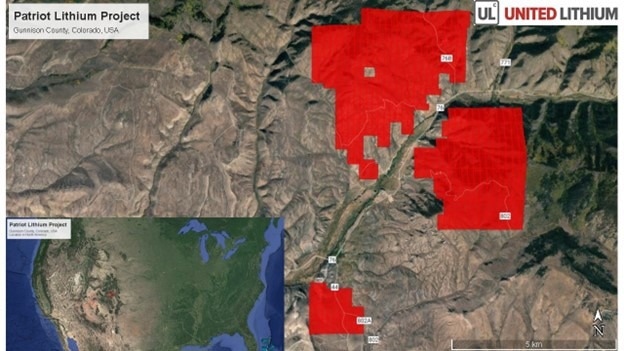Reviewed by Alex SmithOct 14 2022
United Lithium Corp. has announced that they have secured a large land position in the historic lithium-beryllium-producing region of Gunnison County in Colorado.
 Map 1 Patriot Lithium Project Lode Claims (red), Gunnison County, Colorado, USA. Image Credit: United Lithium Corp.
Map 1 Patriot Lithium Project Lode Claims (red), Gunnison County, Colorado, USA. Image Credit: United Lithium Corp.
Near Ohio City, Colorado, and the Black Wonder granite, the company has finished staking more than 300 unpatented lode claims that cover more than 9 mi2 (almost 25 km2).
United Lithium’s claim block encompasses or surrounds all historic LCT (lithium, cesium, tantalum) pegmatite production in the Ohio City area. The “Patriot Lithium Project” has multiple pegmatite bodies, some of which have been mined for Li-Be.
Along with the staking program, a reconnaissance rock chip sampling program was run to find new places for in-depth field exploration. The laboratory has received samples, and tests are pending.
We are planning an integrated exploration program to evaluate the Ohio City area land holdings. The program will include local area detailed geologic mapping and additional rock chip sampling. With anomalies well-defined, targets with be drilled in the coming year when permits and contracts are in place.
Michael Dehn, Chief Executive Officer, President, and Director, United Lithium Corp.
The United Lithium claims are described in detail below. The staked area includes publicly accessible properties managed by the US Forest Service (USFS). Within USFS properties, there are private property holdings, and the claims are situated and located to acknowledge the titled, previous ownership rights.
Historic Lithium-Beryllium Pegmatite Mining in the Ohio City Area
A portion of the Quartz Creek pegmatite field includes the Patriot Lithium project. It is situated in Gunnison County, 17 miles due east of the City of Gunnison. The Patriot Lithium Project consists of three blocks of claims, which are shown on Map 1 and are situated between Parlin and Ohio City in Colorado.
The two “Ohio City” claim blocks in the north are separated from one another by privately held land and a highway right-of-way.
The southern “Parlin” claim block and the Ohio City claims are separated by a series of newer Paleozoic rocks. The US Geological Survey has documented more than 1,800 distinct pegmatite bodies that surround the Black Wonder granite.
The mapped pegmatites show zonation, with the pegmatites nearest to the Black Wonder granite being less evolved and the more distant pegmatites being geochemically evolved and often enriched in lithophile elements such as Li, Be, Sn, Cs, Rb, etc.
In the more advanced pegmatites, lithium and beryllium were once mined and found in occurrences like the well-known Brown Derby pegmatite mine, the Bazooka, White Spar, and Opportunity pegmatites.
Reconnaissance Rock Chip Geochemical Sampling
In the Ohio City and Parlin regions, a geological crew collaborated with the staking team to identify areas that needed to be covered and, more crucially, to collect 243 surface rock chip samples from many pegmatite outcrops for geochemical investigation.
Many of the outcrop samples contained lithium minerals, including large amounts of lepidolite, spodumene, and tourmaline (elbaite), but beryl was the main beryllium mineral.
Monazite, columbite, tantalite, microlite, rynersonite, gahnite, zircon, allanite, amblygolite, pollucite, and stibiotantalite are some other minerals that have been reported in the pegmatites from this region but have not been identified in hand specimens.
The pegmatites in the Ohio City-Parlin area made a substantial contribution to the war efforts in the 1940s and 1950s in addition to the economic growth of the area. The Brown Derby pegmatite mines were notable for producing Li and Be as well as being the home of several rare mineral species.
Final approvals from the Bureau of Land Management are still required for all claims.